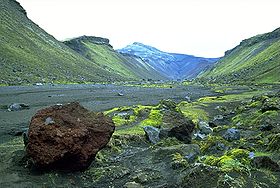Eldgja (Eldgjá) (Fire Gorge)
Eldgja (Eldgjá) (Fire Gorge)
This magnificent 8km long gorge was formed in a powerful explosive fissure eruption around 934.
Curiously, there are no historical references to the eruption, which is odd as it is reckoned to have been one of the most powerful recorded.
As you enter Eldgja on a short detour from road F208, you'll be greeted by moss-clad lava and small craters clustered on the floor of the fissure.
Keep driving until you reach a parking area with toilets and a warden’s office.
Continuing up the gorge on foot, you can't help noticing the huge rocks that have fallen from the gorge rim - the authorities have marked some of these boulders with the date they fell, and some are rather recent arrivals!
The setting is magnificent with the green moss-clad boulders, the rust-red fissure slopes, and the sparkling clear river. Allow plenty of time for photographs in this magical place.
After about 30 minutes the striking waterfall Ofaerufoss comes into view, tumbling over the edge of the chasm in three stages.
A natural stone bridge used to span the lower waterfall but it was destroyed by blocks of ice in the spring melt in 1990.
Many visitors turn around at this point but it really is worth continuing to the falls themselves, where steps leave to a viewing platform over the upper falls.
Allow 90 minutes for the full return hike on a fairly rugged trail. Note that the vegetation is very fragile in this area and it’s important to stick to the marked paths.
At the north end of the fissure, Gjatindur mountain (935m) offers a fine view over Eldgja, if you wish to extend your visit.


